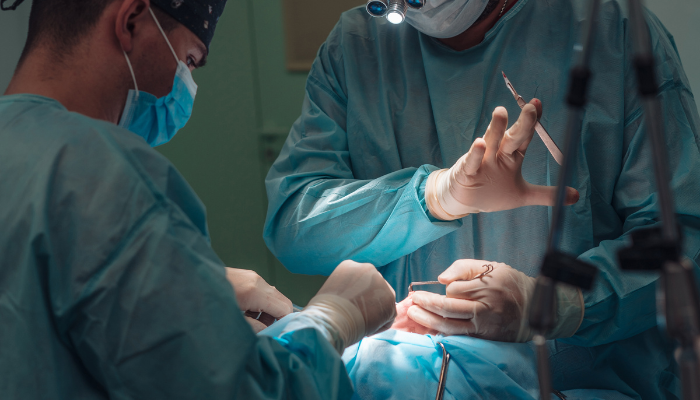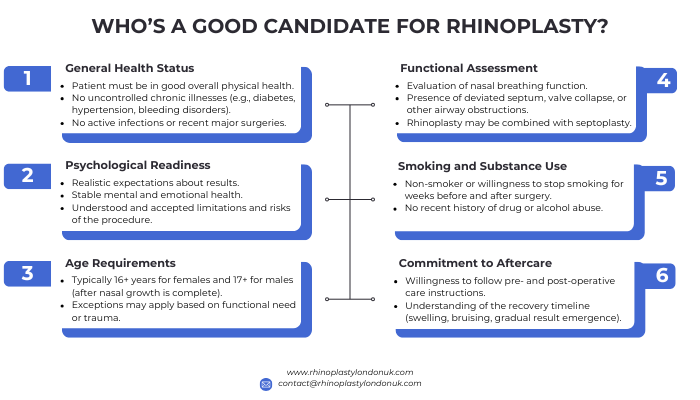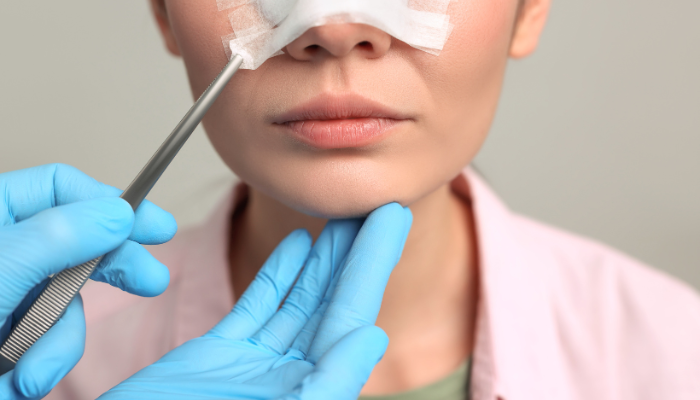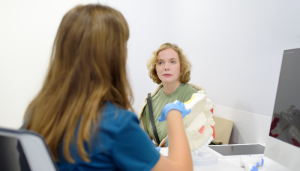Rhinoplasty has gained immense popularity, but with that popularity comes questions about its safety. Many individuals contemplating this procedure might wonder whether it’s a safe option for them.
This article aims to explore the various aspects of rhinoplasty, including its safety, the role of the surgeon, recovery, and the experiences of those who have undergone the procedure.
Key Takeaways
- Rhinoplasty is generally considered safe with a low complication rate of around 0.7%.
- Choosing a qualified and experienced surgeon is crucial for minimising risks during the procedure.
- Post-operative care and follow-up appointments are essential for a smooth recovery process.
- Patients should be well-informed about the potential risks and benefits before undergoing rhinoplasty.
- Alternatives to surgical rhinoplasty, such as non-invasive options, are available for those hesitant about surgery.
Understanding Rhinoplasty Procedures

What Is Rhinoplasty?
Rhinoplasty, often called a ‘nose job’, is a surgical procedure designed to reshape the nose. It’s pretty common, and people get it for all sorts of reasons. Some want to change the way their nose looks, while others need it to improve their breathing. Sometimes, it’s a bit of both.
The cool thing is that each rhinoplasty is tailored to the individual, taking into account their specific anatomy and what they’re hoping to achieve.
Types of Rhinoplasty
There are actually a few different types of rhinoplasty, and the best one for you depends on what you’re trying to fix or change. Here’s a quick rundown:
- Cosmetic Rhinoplasty: This is all about improving the appearance of your nose. Maybe you want to change the size, shape, or angle. It’s all about aesthetics.
- Functional Rhinoplasty: This type focuses on improving how your nose works. It could be to fix breathing problems caused by a deviated septum or other structural issues.
- Reconstructive Rhinoplasty: This is often done to repair damage caused by an injury or to correct a birth defect. It’s about restoring both form and function.
Open vs Closed Rhinoplasty
There are two main approaches to rhinoplasty: open and closed. The difference lies in where the surgeon makes the incisions.
- Open Rhinoplasty: The surgeon makes a small cut on the columella (the bit of skin between your nostrils). This gives them better access and visibility to reshape the bone and cartilage. It’s often used for more complex cases.
- Closed Rhinoplasty: All the incisions are made inside the nostrils. This means there’s no visible scarring, but it can be a bit more challenging for the surgeon to work, and is better suited to minor corrections.
Choosing between open and closed rhinoplasty really depends on your individual needs and what your surgeon recommends. They’ll consider the complexity of the changes you want to make and your overall anatomy to decide which approach is best.
Evaluating Safety in Rhinoplasty
Rhinoplasty, like any surgical procedure, comes with its own set of considerations regarding safety. It’s natural to wonder about the potential risks, but with the right approach, you can significantly minimise them.
Let’s break down the key aspects of safety in rhinoplasty.
Common Risks and Complications
Like any surgery, there are some general risks. These include bleeding, infection, and adverse reactions to the anaesthesia. But don’t panic! These are rare, and your surgical team will take every precaution to prevent them.
Specific to rhinoplasty, some potential issues include:
- Breathing difficulties through the nose
- Numbness in or around the nose (usually temporary)
- Uneven appearance of the nose
- Persistent pain, discoloration, or swelling
- Scarring
- Septal perforation (a hole in the septum)
- Changes in the sense of smell
- The need for revision surgery
It’s important to remember that while these risks exist, they are not common. A skilled surgeon will discuss these with you in detail and take steps to minimise them.
Factors Influencing Safety
Several things can affect how safe your rhinoplasty is. Your overall health plays a big role – pre-existing conditions like diabetes or a bleeding disorder can increase risks.
Lifestyle factors, such as smoking, can also impact healing and increase the chance of complications. The surgeon’s skill and experience are paramount; choosing a board-certified surgeon with a strong track record is crucial.
The type of rhinoplasty (open vs. closed) can also influence the risk profile, with open rhinoplasty sometimes carrying a slightly higher risk due to the more extensive surgical approach.
Patient Selection Criteria

Not everyone is an ideal candidate for rhinoplasty, and that’s okay! Surgeons use specific criteria to determine who is likely to have a safe and successful outcome. These include:
- Good overall physical and mental health
- Realistic expectations about the results
- Adequate nasal structure and tissue quality
- No active nasal infections or untreated sinus problems
- Non-smoker (or willingness to quit before and after surgery)
If you have a bleeding disorder, you might not be a candidate. Your surgeon will assess your medical history and conduct a thorough physical exam to determine if rhinoplasty is right for you.
They’ll look at the inside and outside of your nose, and also consider how the surgery might affect your breathing. It’s all about making sure you’re a good fit for the procedure to minimise risks and maximise your chances of a happy outcome.
The Role of the Surgeon
Choosing the right surgeon is, without a doubt, one of the most important decisions you’ll make when considering rhinoplasty. It’s not just about finding someone who can perform the surgery; it’s about finding someone you trust implicitly with your health and aesthetic goals.
A skilled and experienced surgeon can significantly reduce the risks involved and increase the likelihood of a successful outcome. Let’s explore what to look for in a rhinoplasty surgeon.
Choosing a Qualified Surgeon
Where do you even start? First things first, check their credentials.
- Are they registered with the General Medical Council (GMC)?
They should be listed on the specialist register and have a licence to practise. Surgeons who perform cosmetic procedures are also usually members of professional associations like the British Association of Plastic Reconstruction and Aesthetic Surgeons (BAPRAS) or the British Association of Aesthetic Plastic Surgeons (BAAPS).
Most associations have online registers that you can check to see if your surgeon is listed. Don’t be shy about asking for proof of qualifications and memberships.
Surgeon Experience and Safety
Experience matters, plain and simple. You want a surgeon who has performed a significant number of rhinoplasty procedures. Ask them directly:
- How many nose reshaping operations have they done? H
- ow many operations have they performed where there have been complications?
A surgeon with a solid track record is more likely to handle any unexpected issues that may arise during or after the surgery. It’s also a good idea to ask about their patient satisfaction rates.
Consultation and Pre-Operative Assessment
Before you even think about booking the surgery, you should have a thorough consultation with your surgeon. This isn’t just a quick chat; it’s a chance for them to assess your nasal structure, discuss your goals, and explain what’s realistically achievable.
They should also go over your medical history, any medications you’re taking, and any potential risks or complications.
The consultation is also your opportunity to ask questions and voice any concerns you may have. A good surgeon will listen carefully, provide honest answers, and make you feel comfortable and confident in their abilities. If you don’t feel heard or if you’re pressured into making a decision, it’s a red flag.
Here are some questions you might want to ask during your consultation:
- What are the potential risks and complications of the surgery?
- What sort of follow-up should I expect if things go wrong?
- Can I see before-and-after photos of your previous patients?
Recovery and Aftercare
Expected Recovery Timeline
What’s next? The recovery timeline is something everyone wants to know about, and it’s good to have realistic expectations. Immediately after surgery, you’ll likely have a splint and some packing in your nose. This is normal.
The first week is usually the toughest, with swelling and bruising being most noticeable. After about a week, the splint and any external stitches are usually removed. Bruising starts to fade around the two-week mark, but residual swelling can hang around for several months, sometimes up to a year, before you see the final, final result. It’s a marathon, not a sprint, this recovery business.
Managing Post-Operative Symptoms
Let’s talk about managing those post-op symptoms. Pain is usually controlled with prescription painkillers, but over-the-counter options like paracetamol can help too. Swelling? Ice packs are your best friend. Apply them for 20 minutes at a time, several times a day.
Keep your head elevated, even when sleeping, to help reduce swelling. You’ll probably feel congested, so saline nasal sprays are great for keeping things moist and comfortable.
Just be gentle when cleaning around the nose. Here’s a quick list of things to keep in mind:
- Take pain medication as prescribed.
- Use ice packs to reduce swelling.
- Keep your head elevated.
- Use saline nasal sprays.
It’s important to avoid blowing your nose for a couple of weeks to prevent any complications. Sneeze through your mouth if you need to. And definitely avoid strenuous activity for at least a month. Listen to your body; if something doesn’t feel right, don’t do it.
Importance of Follow-Up Appointments
Follow-up appointments are really important. Your surgeon will want to monitor your healing and make sure everything is progressing as it should. These appointments are also a great opportunity to ask any questions or voice any concerns you might have. Don’t skip them!
They’re there to help you get the best possible outcome. Typically, you’ll have appointments a week after surgery, then a few weeks later, and then at several months post-op. These check-ins allow your surgeon to:
- Assess the healing process.
- Address any complications early.
- Provide guidance on aftercare.
- Ensure you’re happy with the results.
Long-Term Outcomes of Rhinoplasty
Longevity of Results
The results of a rhinoplasty are generally considered permanent, but ‘permanent’ needs a bit of unpacking. Your nose will change naturally over time, just like the rest of your face.
Factors like ageing, sun exposure, and even just general wear and tear can influence its appearance. Most of the swelling will disappear within a year, but it’s important to have realistic expectations.
Impact on Quality of Life
Rhinoplasty isn’t just about looks; it can seriously boost your confidence and how you feel about yourself. If you’ve been self-conscious about your nose for ages, fixing it can be a real game-changer. Breathing problems? Sorting those out can make a massive difference to your day-to-day life. It’s not just about looking better; it’s about feeling better too.
It’s worth remembering that while surgery can address physical concerns, it’s also important to have a solid support system and realistic expectations about the impact on your overall well-being.
Patient Satisfaction Rates
Generally, people who get rhinoplasty are pretty happy with the results. Loads of studies show high satisfaction rates, especially when patients have clear expectations and a good relationship with their surgeon.
But, like with any surgery, there’s always a chance you might need a touch-up later on. It’s not super common, but it happens. Open communication with your surgeon is key to getting the outcome you want.
Here’s a quick look at satisfaction factors:
- Clear communication with the surgeon
- Realistic expectations about results
- Addressing both aesthetic and functional concerns
- Proper post-operative care
Alternatives to Surgical Rhinoplasty
For those considering rhinoplasty, it’s worth exploring the non-surgical options available. While surgical rhinoplasty offers permanent changes, non-surgical alternatives provide temporary solutions with less downtime and fewer risks.
Let’s have a look at what’s out there.
Non-Surgical Options

Non-surgical rhinoplasty, often called a liquid nose job, involves using dermal fillers to reshape the nose. This procedure can address concerns like asymmetry, dorsal humps (bumps on the bridge of the nose), and a poorly defined nasal tip. The fillers, typically hyaluronic acid-based, are injected strategically to create a smoother, more balanced appearance.
The procedure is quick, often taking less than half an hour, and the results are visible almost immediately. However, it’s important to remember that these results are temporary, usually lasting from six months to two years, depending on the type of filler used and individual factors.
Benefits of Non-Invasive Techniques
There are several advantages to choosing non-surgical rhinoplasty:
- Minimal Downtime: Recovery is quick, with most people returning to their normal activities within a day or two.
- Reduced Risks: Non-surgical procedures carry fewer risks compared to surgery, such as infection, bleeding, and anaesthesia-related complications. However, there are still risks, including tissue necrosis, infection and cysts.
- Lower Cost: Non-surgical options are generally less expensive than surgical rhinoplasty.
- Reversible: Because fillers are used, the results can be adjusted or reversed if you’re not happy with the outcome. An enzyme called hyaluronidase can dissolve hyaluronic acid fillers.
Non-surgical rhinoplasty can be a great option for those looking for subtle changes without the commitment and risks of surgery. It’s important to have realistic expectations and understand the limitations of the procedure.
When to Consider Alternatives
Non-surgical rhinoplasty is best suited for people who:
- Want to correct minor imperfections.
- Are looking for a temporary solution before committing to surgery.
- Are not candidates for surgery due to medical reasons.
- Want to avoid the downtime and risks associated with surgery.
It’s important to note that non-surgical rhinoplasty cannot address functional issues like breathing problems or significantly reduce the size of the nose. If you have these concerns, surgical rhinoplasty may be a more appropriate option.
Patient Testimonials and Experiences
Addressing Concerns and Fears
It’s normal to feel anxious about any surgical procedure, and rhinoplasty is no exception. Common concerns include pain, recovery time, and the potential for complications. We want to assure you that these fears are valid, and we’re here to address them.
Open communication with your surgeon is key to managing these anxieties. They can provide realistic expectations, explain the risks involved, and answer any questions you may have.
Many patients find it helpful to speak with others who have gone through the same experience. Hearing firsthand accounts can alleviate fears and provide a sense of reassurance.
Community Support and Resources
Going through rhinoplasty can feel like a solitary journey, but it doesn’t have to be. There are many online and in-person communities where you can connect with others who are considering or have undergone the procedure. These groups offer a space to share experiences, ask questions, and receive support.
Here are some resources you might find helpful:
- Online forums dedicated to rhinoplasty discussions.
- Patient support groups in your local area.
- Informational websites and blogs offering advice and tips.
Conclusion
Rhinoplasty is generally a safe procedure, with a low complication rate. While every surgery carries some risks, the chances of serious issues arising from a nose job are quite minimal. It’s essential to choose a qualified surgeon and follow their pre- and post-operative advice to ensure the best outcome.
If you’re considering rhinoplasty, take the time to research and understand the process, and try this FREE consultation with a qualified surgeon. With the right preparation and care, you can achieve the results you desire while minimising potential risks.
Frequently Asked Questions
What is rhinoplasty?
Rhinoplasty, often called a nose job, is a surgery to change the shape of the nose. It can help improve how the nose looks or works.
How safe is rhinoplasty?
Rhinoplasty is generally safe. Most surgeries have some risks, but complications are rare. The chance of problems is low, especially with a skilled surgeon.
What are the risks of rhinoplasty?
Like all surgeries, rhinoplasty has risks. These can include bleeding, infection, and breathing problems. However, serious issues are uncommon.
How long does recovery take after rhinoplasty?
Recovery from rhinoplasty usually takes about a week. You might have some swelling and bruising, but most people feel better after a week.
Can rhinoplasty change my breathing?
Yes, rhinoplasty can improve breathing issues. Some people have the surgery to fix problems with airflow in the nose.
What should I do before getting rhinoplasty?
Before surgery, you should meet with your surgeon to discuss your health history and goals for the surgery. This helps ensure the best outcome.





